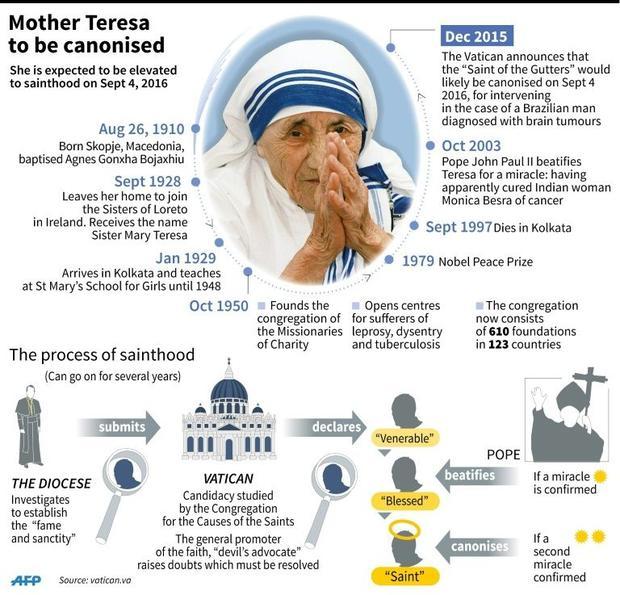 Today, September 4, 2016, Mother Teresa or Blessed Teresa of Calcutta, will officially be recognized as a Saint by the Roman Catholic Church.
Today, September 4, 2016, Mother Teresa or Blessed Teresa of Calcutta, will officially be recognized as a Saint by the Roman Catholic Church.
Note that we didn’t say she would ‘become’ a Saint. This is because, according to the Catholic Church, these individuals have already been made Saints in heaven and this fact has now been verified via the process of Canonization. Canonization does not make a saint; it only recognizes what God has already done.
The road to the canonization of a Saint is an often long, intricate process consisting of several required steps, including two miracles¹ which must be attributed to the intercession of the individual. Let’s take a look at this process.
Servant of God
At least five years after a person’s death—unless a special exception is made by the pope (as in the case of both Pope John Paul II² and Mother Teresa³)— the diocese, religious order, association or lay persons petitioning for the cause asks the diocesan bishop to open an investigation into the martyrdom or life of the person. The bishop investigates if the person lived a heroic virtuous life, exemplifying the virtues of faith, hope and love through the calling of witnesses and the theological examination of the candidates’ writings. If the cause is based on martyrdom, the diocesan bishop investigates the circumstances surrounding the alleged martyrdom, which is also done through the calling of witnesses to the martyrdom and the examination of the candidates’ life. At this stage, the candidate receives the title “Servant of God.”
Venerable Servant of God
Once the diocesan investigation is complete, the documentation that has been collected is sent to the Vatican’s Congregation for the Causes of Saints. If the congregation’s theologians find the documentation convincing, it is sent for review by the cardinal and bishop members of the congregation. If they also find the documentation favorable, it is sent to the pope. Once a candidate has been determined to be virtuous and heroic in his or her faith, he or she is declared “Venerable.”
Blessed
The next step in the process is beatification. For beatification, a miracle must be attributed to the Venerable. The miracle is verified through an examination by a team of medical experts and theologians. The three traditional standards for judging the authenticity of a miracle are: complete—meaning a total healing of the disease, it is not enough for the person to “just” feel better; instantaneous—meaning the healing occurred all at once and not over the course of several days or months; and durable—meaning the person remains permanently free from the illness that afflicted them. If the miracle is verified, the candidate is then presented to the pope. So begins the process of beatification in which the pope determines if the candidate is worthy of the title “Blessed.” Mother Teresa was beatified in October 2003, making her Blessed Mother Teresa of Calcutta
Saint
A second miracle must be attributed to the Blessed in order for him or her to be canonized a saint. The verification of the second miracle follows the same procedure as the first. Once verified, the person is declared a Saint, and he or she is worthy of universal veneration by the Church.

References
¹The Miracles that Made Mother Teresa a Saint, National Catholic Register
²In May 2005, Pope Benedict XVI began the beatification process for Pope John Paul II who had died just one month earlier. “Exceptional circumstances” were cited as reason for waiving the five-year waiting period.
³Pope John Paul II waived more than three years of the waiting period for Mother Teresa, opening the cause for her beatification and sainthood in 1999, less than two years after her death.